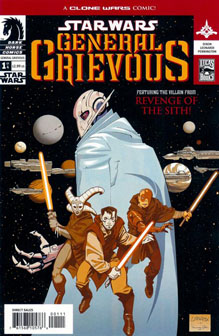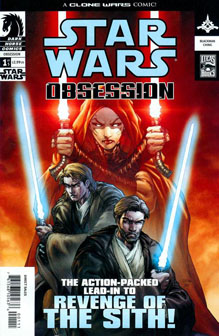The 2008-14 Clone Wars contradicted some things from the 2003-06 Clone Wars, and some of those things were retconned – for example, Lucasfilm’s Leland Chee managed to reconcile Asajj Ventress’ Rattatak and Dathomir backstories in an article for Star Wars Insider Issue 122. Other things simply could not be reconciled, and the contradiction between the five-issue series “Obsession” (2004-05) and Season 4 of “The Clone Wars” is one of them.
In the TV series, Count Dooku aims to have Ventress killed on the orders of Darth Sidious, who feels she is becoming too powerful to be trusted. In “Obsession,” during a battle on Boz Pity, Dooku simply flees without waiting for Ventress – although he does gather up General Grievous (“He cost too much to let him go to waste”). Throughout the “Republic” comics, from which “Obsession” spins off, Ventress doesn’t hone her anger into a reliable weapon, and she embarks on her own missions of vengeance as much as she follows orders (“She has failed me at every turn. Before she becomes a captive of the Republic, finish her,” Dooku orders his minions). In the TV series, Ventress has a finely controlled anger and is completely obedient to Dooku.
One could argue that, aside from the “Clone Wars” microseries where Asajj joins Dooku, most of the comic stories take place before most of the TV stories, thus reflecting Ventress’ increasing reliability as a Separatist lieutenant. However, it makes no sense that Dooku would betray Ventress twice, in two different ways, thus leading Ventress down two different reactionary paths. In “Obsession,” she commandeers a ship and orders the captain to fly “far away. Far from the Jedi, from this war, from Count Dooku.” In the TV series, she vows vengeance on Dooku and – just before the series’ cancellation — begins to team up with the Jedi against their common enemy.
More superficially, Ventress has a cybernetic eye at the end of “Obsession,” and that’s never the case on the TV series.
Written by Haden Blackman, who handled most of the Anakin/Obi-Wan/Ventress stuff on “Republic,” “Obsession” starts with Obi-Wan seemingly out of character, obsessed with finding Ventress. At first it seems he wants to eliminate a major threat to the Republic, but gradually we realize he thinks he can save her from the dark side. Indeed, he believes Anakin could’ve turned out like Ventress had Dooku, rather than Qui-Gon, found him as a boy. In the end, he realizes Anakin was right to believe Obi-Wan has been off his rocker throughout the story: “She really never stopped wanting to kill me, not for a moment,” Obi-Wan reflects.
“Obsession” is also notable for featuring the only appearance of Padme – outside of holograms, flashbacks or dream sequences – during the entire Dark Horse Clone Wars era, as Anakin and Padme carve out a few days of free time on Naboo. Clearly, Dark Horse had no idea what to do with Padme during this time period, so they just ignored her. TV’s “Clone Wars,” smartly, used Padme the same way Dark Horse used Bail Organa, as a heroic politician/warrior.
And “Obsession” dispatches Durge by having Anakin blast him into a sun. Good riddance. The bounty hunter with the incredible healing factor was always a cartoony villain.

General Grievous could’ve become a cartoony bad guy as well (and like Durge, he was introduced in the “Clone Wars” microseries), but the Separatist cyborg always stayed a half-step ahead of silliness, although he never reached the heights of Ventress, Dooku or Darth Maul. A big reason for this is Matthew Wood, who voiced the general in “The Clone Wars.” That leads me to the biggest strength of Marvel veteran Chuck Dixon’s four-issue “General Grievous”: I can imagine all of these arrogant lines being throatily delivered by Wood. For example, take this exchange:
Grievous: “Within days of landing forces on the planet, we have suppressed resistance entirely.”
Separatist officer: “By annihilating the native population.”
Grievous: “I find that the most efficient form of suppression.”
Unfortunately, “General Grievous” is not what it should have been: the character’s origin story. (A taste of his origin can be found in the “Visionaries” trade paperback from April 2005, although those stories from various “Revenge of the Sith” concept artists are not considered canon.) Instead, “General Grievous” is one of those all-too-typical yarns where the villain is in the title but generic Jedi are the main characters. An additional note of interest: We meet a group of younglings who are sort of a prototypical Zatt, Gungi, Ganodi, Byph, Petro and Katooni (from “The Clone Wars” Season 5).
“Grievous” contradicts “Obsession” – or shows the hypocrisy of the Jedi Council – in an interesting way. In “Obsession,” Obi-Wan takes it upon himself to track down Ventress. Aayla Secura reminds Obi-Wan he’s supposed to be on leave, and he justifies his actions thusly: “Master Windu may not have assigned my current mission, but it’s important to the war effort.” In “Grievous,” Padawan Flynn Kybo joins a group of Jedi planning a mission to assassinate Grievous against the Council’s wishes. “Go, Padawan, do as you must,” Flynn’s master says. “But know that you will never be offered a place among the Jedi again.”
The difference in treatment is not based on rank, as all the Jedi among Grievous’ would-be assassins are banished from the order, not just the Padawans. One could assume that certain Jedi – Anakin, Obi-Wan and basically everyone who is represented with a Hasbro action figure – are treated differently than those who appear in only one story. But I suspect Dixon’s hard-line stance against these rogue Jedi is overplayed given how thin the Jedi are stretched in the war.
The slightly off-base portrayal of the Jedi Council in “Grievous” can be chalked up to a one-time “Star Wars” writer, whereas “Obsession’s” continuity problems are a case of George Lucas coming in later with “The Clone Wars” TV show and telling the official Ventress story. Either way, these two titles are rough around the edges and make me appreciate John Ostrander’s smooth, detail-conscious storytelling in the main “Republic” title all the more.


